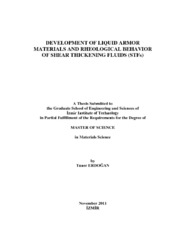Please use this identifier to cite or link to this item:
https://hdl.handle.net/11147/3183Full metadata record
| DC Field | Value | Language |
|---|---|---|
| dc.contributor.advisor | Tanoğlu, Metin | - |
| dc.contributor.author | Erdoğan, Taner | - |
| dc.date.accessioned | 2014-07-22T13:51:02Z | - |
| dc.date.available | 2014-07-22T13:51:02Z | - |
| dc.date.issued | 2011 | - |
| dc.identifier.uri | http://hdl.handle.net/11147/3183 | - |
| dc.description | Thesis (Master)--Izmir Institute of Technology, Materials Science and Engineering, Izmir, 2011 | en_US |
| dc.description | Includes bibliographical references (leaves: 127-129) | en_US |
| dc.description | Text in English; Abstract: Turkish and English | en_US |
| dc.description | xviii, 129 leaves | en_US |
| dc.description | Full text release delayed at author's request until 2014.12.18 | en_US |
| dc.description.abstract | Colloidal dispersions have been extensively used in many industrial applications such as cosmetic, paint, cement, lubricant and ceramic. Shear thickening is non- Newtonian flow behavior often observed in concentrated colloidal dispersions as an increase in viscosity with increasing shear rate or applied stress. Shear thickening fluids (STFs) exhibit fluid and solid-like properties depending on the shear rate and thus can be used in a variety of applications. In the present study, STFs have been synthesized with various weight fractions of silica nanoparticles in polyethylene glycol (PEG)/ethyl alcohol by mechanical mixing method. The steady and dynamic rheological behavior of shear thickening fluids (STFs) was investigated with rheometer. STFs thermal properties were investigated through thermogravimetric analysis. STFs have been used to improve the performance of Kevlar woven fabrics for protective applications in ballistic and stab. STFs/Kevlar fabric composites have been prepared with different impregnation techniques to evaluate the effects of the STFs. The ballistic performance and stab resistance of STFs impregnated Kevlar fabrics were investigated. Rheological measurements revealed the shear thickening effect of silica nanoparticles/PEG systems depending on the shear rate. In dynamic experiments, the strain thickening behavior was found at critical combination of strain amplitude and frequency. The viscous G modulus values were found to be greater than the elastic G modulus. The elastic G and the viscous G modulus values were found to increase when the strain amplitude is kept constant and frequency is increased. The same strain thickening behavior was also found when the frequency was kept constant and the strain amplitude was increased. The puncture resistance of STFs/Kevlar fabric composites exhibited significant improvements as compared to the neat Kevlar targets. Based on the SEM results, STFs were uniformly impregnated over the entire surface on the Kevlar fabric and Kevlar fabrics completely coated with STFs. The ballistic test results revealed STF/Kevlar fabric composites have potential to obtain liquid armor materials. | en_US |
| dc.language.iso | en | en_US |
| dc.publisher | Izmir Institute of Technology | en_US |
| dc.rights | info:eu-repo/semantics/openAccess | en_US |
| dc.subject.lcsh | Rheology | en |
| dc.subject.lcsh | Shear flow | en |
| dc.subject.lcsh | Polymers | en |
| dc.subject.lcsh | Nanoparticles | en |
| dc.subject.lcsh | Composite materials | en |
| dc.subject.lcsh | Colloids | en |
| dc.subject.lcsh | Silica | en |
| dc.title | Development of Liquid Armor Materials and Rheological Behavior of Shear Thickening Fluids (stfs) | en_US |
| dc.type | Master Thesis | en_US |
| dc.institutionauthor | Erdoğan, Taner | - |
| dc.department | Thesis (Master)--İzmir Institute of Technology, Materials Science and Engineering | en_US |
| dc.relation.publicationcategory | Tez | en_US |
| dc.identifier.wosquality | N/A | - |
| dc.identifier.scopusquality | N/A | - |
| item.grantfulltext | open | - |
| item.fulltext | With Fulltext | - |
| item.languageiso639-1 | en | - |
| item.openairetype | Master Thesis | - |
| item.cerifentitytype | Publications | - |
| item.openairecristype | http://purl.org/coar/resource_type/c_18cf | - |
| Appears in Collections: | Master Degree / Yüksek Lisans Tezleri | |
Files in This Item:
| File | Description | Size | Format | |
|---|---|---|---|---|
| 419340.pdf | MasterThesis | 5.02 MB | Adobe PDF |  View/Open |
CORE Recommender
Page view(s)
362
checked on Jun 16, 2025
Download(s)
224
checked on Jun 16, 2025
Google ScholarTM
Check
Items in GCRIS Repository are protected by copyright, with all rights reserved, unless otherwise indicated.